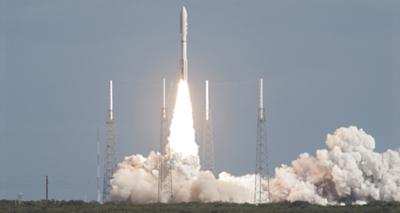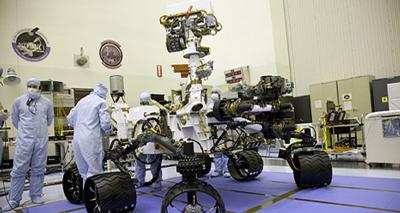Rover 'Curiosity' To Explore Mars 8 1/2 Months From
Now
NASA began a historic voyage to Mars with the Nov. 26 launch of
the Mars Science Laboratory (MSL), which carries a car-sized rover
named Curiosity. Liftoff from Cape Canaveral Air Force Station
aboard an Atlas V rocket occurred at 1002 EST.

"We are very excited about sending the world's most advanced
scientific laboratory to Mars," NASA Administrator Charles Bolden
said. "MSL will tell us critical things we need to know about Mars,
and while it advances science, we'll be working on the capabilities
for a human mission to the Red Planet and to other destinations
where we've never been."
The mission will pioneer precision landing technology and a
sky-crane touchdown to place Curiosity near the foot of a mountain
inside Gale Crater on Aug. 6, 2012. During a nearly two-year prime
mission after landing, the rover will investigate whether the
region has ever offered conditions favorable for microbial life,
including the chemical ingredients for life.
"The launch vehicle has given us a great injection into our
trajectory, and we're on our way to Mars," said MSL Project Manager
Peter Theisinger of NASA's Jet Propulsion Laboratory (JPL) in
Pasadena, Calif. "The spacecraft is in communication, thermally
stable and power positive."
The Atlas V initially lofted the spacecraft into Earth orbit and
then, with a second burst from the vehicle's upper stage, pushed it
out of Earth orbit into a 352-million-mile journey to
Mars.

"Our first trajectory correction maneuver will be in about two
weeks," Theisinger said. "We'll do instrument checkouts in the next
several weeks and continue with thorough preparations for the
landing on Mars and operations on the surface."
Curiosity's ambitious science goals are among the mission's many
differences from earlier Mars rovers. It will use a drill and scoop
at the end of its robotic arm to gather soil and powdered samples
of rock interiors, then sieve and parcel out these samples into
analytical laboratory instruments inside the rover. Curiosity
carries 10 science instruments with a total mass 15 times as large
as the science-instrument payloads on the Mars rovers Spirit and
Opportunity. Some of the tools are the first of their kind on Mars,
such as a laser-firing instrument for checking rocks' elemental
composition from a distance, and an X-ray diffraction instrument
for definitive identification of minerals in powdered samples.
To haul and wield its science payload, Curiosity is twice as
long and five times as heavy as Spirit or Opportunity. Because of
its one-ton mass, Curiosity is too heavy to employ airbags to
cushion its landing as previous Mars rovers could. Part of the MSL
spacecraft is a rocket-powered descent stage that will lower the
rover on tethers as the rocket engines control the speed of
descent.

The mission's landing site offers Curiosity access for driving
to layers of the mountain inside Gale Crater. Observations from
orbit have identified clay and sulfate minerals in the lower
layers, indicating a wet history.
Precision landing maneuvers as the spacecraft flies through the
Martian atmosphere before opening its parachute make Gale a safe
target for the first time. This innovation shrinks the target area
to less than one-fourth the size of earlier Mars landing targets.
Without it, rough terrain at the edges of Curiosity's target would
make the site unacceptably hazardous.
The innovations for landing a heavier spacecraft with greater
precision are steps in technology development for human Mars
missions. In addition, Curiosity carries an instrument for
monitoring the natural radiation environment on Mars, important
information for designing human Mars missions that protect
astronauts' health.
The mission is managed by JPL for NASA's Science Mission
Directorate in Washington. The rover was designed, developed and
assembled at JPL. NASA's Launch Services Program at the Kennedy
Space Center in Florida managed the launch. NASA's Space Network
provided space communication services for the launch vehicle.
NASA's Deep Space Network will provide spacecraft acquisition and
mission communication. United Launch Alliance, Denver, Colo.,
provided the Atlas V launch vehicle.
 ANN's Daily Aero-Linx (04.13.24)
ANN's Daily Aero-Linx (04.13.24) ANN's Daily Aero-Term (04.13.24): Beyond Visual Line Of Sight (BVLOS)
ANN's Daily Aero-Term (04.13.24): Beyond Visual Line Of Sight (BVLOS) Airborne 04.09.24: SnF24!, Piper-DeltaHawk!, Fisher Update, Junkers
Airborne 04.09.24: SnF24!, Piper-DeltaHawk!, Fisher Update, Junkers Aero-News: Quote of the Day (04.14.24)
Aero-News: Quote of the Day (04.14.24) ANN's Daily Aero-Term (04.14.24): Maximum Authorized Altitude
ANN's Daily Aero-Term (04.14.24): Maximum Authorized Altitude





